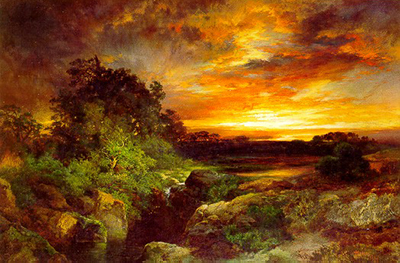Visitors to the Grand Canyon can thank Thomas Moran for its status as an American national park.
His dramatic pictures of the region's rugged terrain awakened national interest, and he continued to portray the area all his life, finishing An Arizona Sunset near the Grand Canyon in 1898. Moran had started his working life as an apprentice engraver, but turned to illustrations, before leaving to concentrate on painting. In 1871, joining the first survey of Yellowstone, his sketches captured the public's imagination, and led to the creation of the first national park. He first visited the Grand Canyon in 1873, and again, his scenes of the area led to it becoming a national park in 1919. Moran produced many paintings of the region, with An Arizona Sunset near the Grand Canyon being just one.
Moran, who was also skilled in etching, lithography and chromolithography, initially studied under a local artist, James Hamilton. The work with book illustrations in his early years had introduced him to J. M. W. Turner's masterpieces, and the English artist became a strong influence, with Thomas visiting England to see the works first-hand. He was particularly taken with Turner's watercolours, and his use of vibrant colours, which became so prevalent in Moran's work.
Moran described the colour of the Grand Canyon as red, and in An Arizona Sunset near the Grand Canyon, shades of red, gold, orange and yellow set alight the approaching night sky, casting a glow over the greenery and rocks in the foreground. The oil-on-canvas scene has an almost biblical feel that harks back to Turner's early traditional work, with its more pastoral themes.
Thomas Moran was a member of New York's Hudson River School, and with Thomas Hill, Albert Bierstadt and William Keith, was part of the Rocky Mountain School which specialised in Western scenery. Moran was actually born in Bolton, England in 1837, and didn't emigrate to the United States until the 1840s. It's possible that he saw the landscape from an outsider's viewpoint, with fresh eyes, enabling him to pass on his enthusiasm to the public. In addition, his fantasy paintings of the 1860s owe something to the American Pre-Raphaelites, with their detailed landscapes and studies of nature. He also travelled and worked widely outside of the U.S., as far away as Venice.
Thomas Moran's work is still admired today, so much so that one of his paintings hangs in the Oval Office at the White House, residence of the President of the United States. His influence can still be seen in North American art, and in photographic work such as that of Ansel Adams, prominent landscape photographer of the twentieth century. An Arizona Sunset near the Grand Canyon is typical of the output that earned him his reputation.




